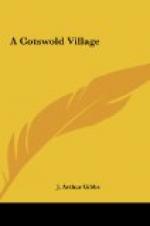The place is so rich in Roman antiquities that we must perforce devote a few lines to their consideration. A whole book would not be sufficient to do full justice to them.
No less than four important Roman roads meet within a short distance of Cirencester; and very fine and broad ones they are, generally running as straight as the proverbial arrow.
1. The Irmin Way, between Cricklade and Gloucester, via Cirencester.
2. Acman Street connects Cirencester with Bath.
3. Icknield Street, running to Oxford.
4. The Fossway, extending far into the north of England. This magnificent road may be said to connect Exeter in the south with Lincoln in the north. It is raised several feet above the natural level of the country, and in many places there still remain traces of the ancient ditch which was dug on either side of its course.
In the year 1849 two very fine tessellated pavements were unearthed in Dyer Street, and removed to a museum which Lord Bathurst built purposely for their reception and preservation. Another fine specimen of this kind of work may be seen in its original position at a house called the “Barton” in the park. It is a representation of Orpheus and his lute; and the various animals which he is said to have charmed are wonderfully worked in the coloured pavements. Even as far back as three hundred years ago these beautiful relics were being discovered in this town; for Leland in his “Itinerary,” mentions the finding of some tesserae; unfortunately but few have been preserved.
There are two inscribed stones in this collection which deserve special mention, as they are marvellously well preserved, considering the fact that they are probably eighteen hundred years old. They are about six feet in height and about half that breadth; on each is carved the figure of a mounted soldier, spear in hand. On the ground lies his prostrate foe, pierced by his adversary’s spear. Underneath one of these carvings are inscribed the following words:—
DANNICVS. EQES.
AIAE.
INDIAN. TVR.
ALBANI.
STIP. XVI.
CIVES. RAVR.
CVR. FVLVIVS.
NATALIS. IT.
FVLIVS. BITVCVS.
EX. TESTAME.
H S E.
The meaning of the above words is as follows:—
“Dannicus, a horseman of Indus’s Cavalry, of the squadron of Albanus. He had seen sixteen years’ service. A citizen of Rauricum. Fulvius Natalis and Fulvius Bitucus have caused this monument to be made in accordance with his will. He is buried here.”
The other stone has a somewhat similar inscription.
The Romans, who did not use wallpapers, were in the habit of colouring their plaster with various pigments. Some very interesting specimens of wall-painting are preserved at Cirencester, and may be seen in the museum. The most remarkable example of the kind is a piece of coloured plaster, with the following square scratched on its surface:—




